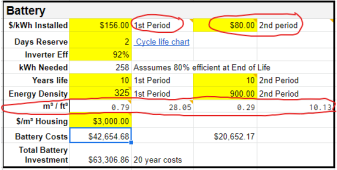247 kWh is simply not $148,000 at $300/kW but half that.
Yeah that's a rough 20 year cost based on needing to update/replace storage along the way. Stuff wears out. Stuff goes wrong. Who knows what the future costs will be?
It's all back of the Excel envelope stuff.
When you are the grid, you are responsible for building, running and maintaining it. For life. Or as long as you expect to be there.
Meanwhile my local grid company employs 3,500 people and has local contractors as well for much of their maintenance and building work. They visit my property about annually for a check of the poles and wires they are responsible for, and of course constantly monitor their network. They know the instant we are disconnected, and the issue and ETA for restoration are updated online. They have government regulated standards for service levels and system restoration. In the meantime for just a few $grand I have backup power for those occasions to tide us over.
I don't need to be around, or arrange for and wait for an electrician to come out to fix my own power station fault (called my electrician yesterday - it will be 3-4 weeks before he can come to fix some suff and install my smart hot water solar PV diverter).
As I mentioned earlier, a project requiring ~0.25MWh of storage would require a dedicated power station building the scale of which is like a decent sized single car garage, with some form of climate control (to mostly deal with the Summer heat), be secure from ingress by insects and other creatures, be appropriately accessible for humans, as well as be suitably fire rated/protected - both from inside should something go horribly wrong in there, but also from the outside given we are subject to bushfire threats at times. Perhaps housed in a suitably modified shipping container.
I'd also need to allow for ground mounts for PV arrays in the field and associated cable trenching. It would not be cheap and these extra costs are not including in the sheet's cost assumptions. Now I have an extra building which will also require maintenance and upkeep.
Almost none of this could be built as a DIY project. Code here requires such a facility be installed by qualified licensed specialists, as would any ongoing changes, modifications, updates etc. I'd need to have a service contractor who could be on call should something go wrong. That'd probably require an annual retainer.
Other than a replacement cost assumption, there is no allowance for the fact this also requires high quality monitoring and a fair bit of personal time devoted to making sure everything is running as it should.
But here comes the fun part.
That daily consumption data (showing max 2-day consecutive consumption of 182kWh) was just for calendar year 2021. If I go back to late 2018 (when my very detailed energy data collection starts) our max consecutive 2-day consumption is 257kWh.
Then you also have to factor in:
- how long you expect to be at this location, and
- the impact on property value should one wish to sell and move on, and
- increase in insurance premiums to cover for the mini power station (due to the fires and floods over past 2 years our premium went up 22% this year)
It's my opinion that taking
our property off-grid would reduce the property's sale value, quite considerably. Any prospective new owners would have to establish the risks of inheriting an off-grid personal power station. A majority would rule the property out from consideration, especially considering all neighbouring properties are on the grid.
If you are buying a block in the wilderness to create a new home, then it's a different scenario.





